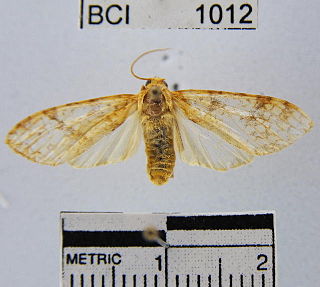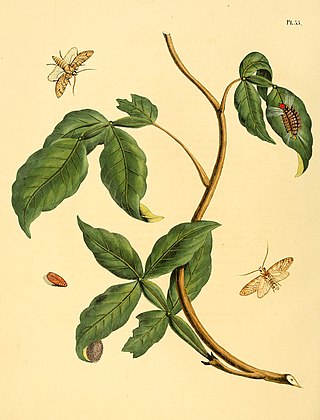
Callenya melaena, the metallic hedge blue, is a small butterfly found in India that belongs to the lycaenids or blues family.

Amblypodia anita, the purple leaf blue or leaf blue, is a lycaenid or blue butterfly found in South Asia and Southeast Asia, including Sri Lanka, India, Myanmar, Malaysia, and Java. The species was first described by William Chapman Hewitson in 1862.

Sabatinca doroxena is a species of moth belonging to the family Micropterigidae. It is endemic to the North Island of New Zealand. This small moth has a colourful forewing pattern with stripes and dots evident. It has been hypothesised that the forewing pattern is intended to resemble a jumping spider in order to allow the adult moth to escape predation. Adults of this species are on the wing from the beginning of September until mid January. It prefers damp but sunny habitat in deep forest, at the forest edge or in open shrubland. Larvae feed on foliose liverwort species including on Leptoscyphus normalis. Adults of this species have been located at the blossoms of flowering Cordyline and Ranunculus species.

Lophocampa catenulata is a moth of the family Erebidae. It was described by Jacob Hübner in 1812. It is found on Cuba and in Mexico, Costa Rica, Guatemala, Panama, Venezuela, Suriname, French Guiana, Brazil, Peru and Argentina.

Lophocampa citrina is a moth of the family Erebidae. It was described by Jan Sepp in 1843 as Phalaena citrina. It is found in Mexico, Honduras, Panama, French Guiana, Brazil, Venezuela and the Amazon region.
Microblepsis acuminata is a moth in the family Drepanidae. It was described by John Henry Leech in 1890. It is found in the Chinese provinces of Hubei and Shaanxi and in Japan.
Oreta bicolor is a moth in the family Drepanidae. It was described by William Warren in 1897. It is found in Sundaland and Malaysia.
Inga analis is a moth in the family Oecophoridae. It was described by August Busck in 1914. It is found in Panama.
Inga crucifera is a moth in the family Oecophoridae. It was described by August Busck in 1914. It is found from Panama to Peru.
Inga ancorata is a moth in the family Oecophoridae. It was described by Lord Walsingham in 1912. It is found in Costa Rica, Colombia, Guyana and Brazil.
Epermenia symmorias is a moth in the family Epermeniidae. It was described by Edward Meyrick in 1923. It is found in Fiji.
Cotana unistrigata is a moth in the family Eupterotidae. It was described by George Thomas Bethune-Baker in 1904. It is found in New Guinea.
Striginiana nobilis is a moth in the family Eupterotidae. It was described by William Jacob Holland in 1893. It is found in Gabon.
Papuapterote crenulata is a moth in the family Eupterotidae. It was described by James John Joicey and George Talbot in 1916. It is found on New Guinea.
Dichomeris deltaspis is a moth in the family Gelechiidae. It was described by Edward Meyrick in 1905. It is found in Sri Lanka. The Global Lepidoptera Names Index has this species as a synonym of Dichomeris bisignella.
Anthistarcha geniatella is a moth in the family Gelechiidae. It was described by August Busck in 1914. It is found in Panama.
Hypatima dissidens is a species of moth in the family Gelechiidae. It was described by Edward Meyrick in 1913. It is found in Mpumalanga, South Africa.
Hypatima euplecta is a species of moth in the family Gelechiidae. It was described by Edward Meyrick in 1904. It is found in Australia, where it has been recorded from Queensland, New South Wales, Victoria and South Australia.
Hypatima isotricha is a species of moth in the family Gelechiidae. It was described by Edward Meyrick in 1921. It is found on Java in Indonesia.
Hypatima hora is a moth in the family Gelechiidae. It was described by August Busck in 1914. It is found in Panama.




